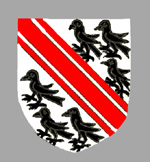Cople Manor

The Gostwick family coat of arms
Volume III of The Victoria County History for Bedfordshire, published in 1912, gives the histories of each of the six manors in the parish. Cople Manor was owned by Chicksands Priory and originated in a grant made by Adeliza, wife of Wigan mentioned in the foundation charter of the priory of around 1150.
In 1291 the manor was worth £10/8/8. The priory was dissolved during Henry VIII's attack on religious houses in England and in 1539 Cople Manor was granted to Sir John Gostwick of Willington. He died in 1545 and was succeeded by his son, who died in the same year, then by his brother William who died in 1549. William's son, another John, succeeded him. His son, another William was High Sheriff of Bedfordshire in 1595 and was created a baronet by King James I (1603-1625) in 1611. His grandson Edward was deaf and dumb but married, succeeded as Lord of the Manor and had children, his second son William being High Sheriff in 1679/80 and Member of Parliament for Bedfordshire from 1698 to 1713. He acquired Woodend Manor in 1686. His grandson William sold Cople Manor in 1731 to Sarah, Duchess of Marlborough, widow of the great general, the victor of Blenheim, she died in 1744.
In 1779 the Duke of Bedford purchased Cople Manor from the Duke of Marlborough and it remained in the family's possession until 1902 when it was sold to George and James Keeble of Peterborough. The manorial estate was quickly broken up with Colonel Frank Shuttleworth of Old Warden being the principal landowner in Cople. A succession of Law of Property Acts in the 1920s abolished manorial fines and incidents as well as copyhold land tenure, thus abolishing manors in practically all but name.